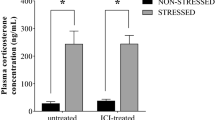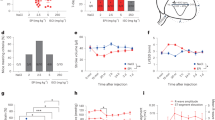Abstract
We investigated cardiac and vascular gene profiles in response to immobilization stress (IMO) in rats, an animal model of emotional stress-induced takotsubo cardiomyopathy using microarray analysis, followed by re-confirmation with real-time reverse transcription-polymerase chain reaction. Expression levels of the identified genes were further estimated by pretreatment with an α1-adrenoceptor blocker and/or a β1-adrenoceptor blocker. In response to IMO, expression of 46 genes was significantly altered in the heart and that of 49 genes was significantly altered in the aorta. Pathway analysis with DAVID Bioinformatics Resources indicated that regulation of transcription and response to endogenous stimulation were the top two scoring pathways. Altered expression of cardiac genes was blunted by pretreatment with a β1-adrenoceptor blocker or α1 + β1-adrenoceptor blockers. In contrast, that of aortic genes was blunted by pretreatment with an α1-adrenoceptor blocker or α1 + β1-adrenoceptor blockers. Activation of α1-adrenoceptor in the blood vessels or activation of β1-adrenoceptors in the heart were mainly responsible for emotional stress-induced alteration of cardiac and vascular gene profiles.

Similar content being viewed by others
References
Steptoe A, Brydon L (2009) Emotional triggering of cardiac events. Neurosci Biobehav Rev 33:63–70
Esler M (2009) Heart and mind: psychogenic cardiovascular disease. J Hypertens 27:692–695
Kurisu S, Sato H, Kawagoe T, Ishihara M, Shimatani Y, Nishioka K, Kono Y, Umemura T, Nakamura S (2002) Tako-tsubo-like left ventricular dysfunction with ST-segment elevation: a novel cardiac syndrome mimicking acute myocardial infarction. Am Heart J 143:448–455
Akashi YJ, Goldstein DS, Barbaro G, Ueyama T (2008) Takotsubo cardiomyopathy: a new form of acute, reversible heart failure. Circulation 118:2754–2762
Sato M, Fujita S, Saito A, Ikeda Y, Kitazawa H, Takahashi M, Ishiguro J, Okabe M, Nakamura Y, Nagai T, Watanabe H, Kodama M, Aizawa Y (2006) Increased incidence of transient left ventricular apical ballooning (so-called ‘Takotsubo’ cardiomyopathy) after the mid-Niigata Prefecture earthquake. Circ J 70:947–953
Jim MH, Chan AO, Tsui PT, Lau ST, Siu CW, Chow WH, Lau CP (2009) A new ECG criterion to identify takotsubo cardiomyopathy from anterior myocardial infarction: role of inferior leads. Heart Vessels 24:124–130
Mariscalco G, Cattaneo P, Rossi A, Baravelli M, Piffaretti G, Scannapieco A, Nassiacos D, Sala A (2010) Tako-tsubo cardiomyopathy complicated by ventricular septal perforation and septal dissection. Heart Vessels 25:73–75
Kvetnanský R, Goldstein DS, Weise VK, Holmes C, Szemeredi K, Bagdy G, Kopin IJ (1992) Effects of handling or immobilization on plasma levels of 3,4-dihydroxyphenylalanine, catecholamines, and metabolites in rats. J Neurochem 58:2296–2302
Ueyama T, Yoshida K, Senba E (2000) Stress-induced elevation of the ST segment in the rat electrocardiogram is normalized by an adrenoceptor blocker. Clin Exp Pharmacol Physiol 27:384–386
Ueyama T, Kasamatsu K, Yamamoto K, Yamamoto K, Tsuruo Y, Nishio I (2002) Emotional stress induces transient left ventricular hypo-contraction in the rat via activation of cardiac adrenoceptors—a possible animal model of tako-tsubo cardiomyopathy. Circ J 66:712–713
Ueyama T (2004) Emotional stress-induced Tako-tsubo cardiomyopathy: animal model and molecular mechanism. Ann N Y Acad Sci 1018:437–444
Ueyama T, Yoshida K, Senba E (1999) Emotional stress induces expression of immediate early genes in rat heart via activation of α- and β-adrenoceptors. Am J Physiol Heart and Circ Physiol 277:H1553–H1561
Ueyama T, Hano T, Kasamatsu K, Yamamoto K, Tsuruo Y, Nishio I (2003) Estrogen attenuates the emotional stress-induced cardiac responses in the animal model of tako-tsubo (Ampulla) cardiomyopathy. J Cardiovasc Pharmacol 42:S117–S119
Ueyama T, Tanioku T, Nuta J, Kujira K, Ito T, Nakai S, Tsuruo Y (2006) Estrogen alters c-Fos response to immobilization stress in the brain of ovariectomized rats. Brain Res 1084:67–79
Ueyama T, Ishikura F, Matsuda A, Asanuma T, Ueda K, Ichinose M, Kasamatsu K, Hano T, Akasaka T, Tsuruo Y, Morimoto K, Beppu S (2007) Chronic estrogen supplementation following ovariectomy improves the emotional stress-induced cardiovascular responses by indirect action on the nervous system and by direct action on the heart. Circ J 71:565–573
Ueyama T, Kasamatsu K, Hano T, Tsuruo Y, Ishikura F (2008) Catecholamines and estrogen are involved in the pathogenesis of emotional stress-induced acute heart attack. Ann N Y Acad Sci 1148:479–485
Zohlnhöfer D, Nührenberg TG, Haas F, Bengel F, Schömig A, Baeuerle PA, Schwaiger M (2008) Myocardial gene expression of matched hibernating and control tissue from patients with ischemic left ventricular dysfunction. Heart Vessels 23:230–242
Liu X, Serova L, Kvetnanský R, Sabban EL (2008) Identifying the stress transcriptome in the adrenal medulla following acute and repeated immobilization. Ann N Y Acad Sci 1148:1–28
Yamamoto Y, Tanahashi T, Kawai T, Chikahisa S, Katsuura S, Nishida K, Teshima-Kondo S, Sei H, Rokutan K (2009) Changes in behavior and gene expression induced by caloric restriction in C57BL/6 mice. Physiol Genomics 39:227–235
Nef HM, Möllmann H, Troidl C, Kostin S, Böttger T, Voss S, Hilpert P, Krause N, Weber M, Rolf A, Dill T, Schaper J, Hamm CW, Elsässer A (2008) Expression profiling of cardiac genes in Tako-Tsubo cardiomyopathy: insight into a new cardiac entity. J Mol Cell Cardiol 44:395–404
Huang da W, Sherman BT, Lempicki RA (2009) Systematic and integrative analysis of large gene lists using DAVID bioinformatics resources. Nat Protoc 4:44–57
Ueyama T, Kawabe T, Hano T, Tsuruo Y, Ueda K, Ichinose M, Kimura H, Yoshida K (2009) Up-regulation of hemeoxygenase 1 in an animal model of takotsubo cardiomyopathy. Circ J 73:1141–1146
Liu Y, Sinha S, McDonald OG, Shang Y, Hoofnagle MH, Owens GK (2005) Kruppel-like factor 4 abrogates myocardin-induced activation of smooth muscle gene expression. J Biol Chem 280:9719–9727
Hamik A, Lin Z, Kumar A, Balcells M, Sinha S, Katz J, Feinberg MW, Gerzsten RE, Edelman ER, Jain MK (2007) Kruppel-like factor 4 regulates endothelial inflammation. J Biol Chem 282:13769–13779
Nobori K, Ito H, Tamomori-Adachi M, Adachi S, Ono Y, Kawauchi J, Kitajima S, Marumo F, Isobe M (2002) ATF3 inhibits doxorubicin-induced apoptosis in cardiac myocytes: a novel cardioprotective role of ATF3. J Mol Cell Cardiol 34:1387–1397
Wier WG, Morgan KG (2003) Alpha1-adrenergic signaling mechanisms in contraction of resistance arteries. Rev Physiol Biochem Pharmacol 150:91–139
Saucerman JJ, McCulloch AD (2006) Cardiac beta-adrenergic signaling: from subcellular microdomains to heart failure. Ann N Y Acad Sci 1080:348–361
Singh K, Communal C, Sawyer DB, Colucci WS (2000) Adrenergic regulation of myocardial apoptosis. Cardiovasc Res 45:713–719
Goldspink DF, Burniston JG, Ellison GM, Clark WA, Tan LB (2004) Catecholamine-induced apoptosis and necrosis in cardiac and skeletal myocytes of the rat in vivo: the same or separate death pathways? Exp Physiol 89:407–416
Snoeckx LH, Cornelussen RN, Van Nieuwenhoven FA, Reneman RS, Van Der Vusse GJ (2001) Heat shock proteins and cardiovascular pathophysiology. Physiol Rev 81:1461–1497
Paier A, Agewall S, Kublickiene K (2009) Expression of heat shock proteins and nitrotyrosine in small arteries from patients with coronary heart disease. Heart Vessels 24:260–266
Shintani-Ishida K, Nakajima M, Uemura K, Yoshida K (2006) Ischemic preconditioning protects cardiomyocytes against ischemic injury by inducing GRP78. Biochem Biophys Res Commun 345:1600–1605
Yet SF, Tian R, Layne MD, Wang ZY, Maemura K, Solovyeva M, Ith B, Melo LG, Zhang L, Ingwall JS, Dzau VJ, Lee ME, Perrella MA (2001) Cardiac-specific expression of heme oxygenase-1 protects against ischemia and reperfusion injury in transgenic mice. Circ Res 89:168–173
Acknowledgments
We thank Dr Edith D. Hendley (Department of Molecular Physiology and Biophysics, University of Vermont College of Medicine, Burlington, VT, USA) for helpful comments and careful reading of the manuscript. This work was supported in part by Grants-in-Aid from the Japan Society for the Promotion of Science (20390193 and 21590771).
Author information
Authors and Affiliations
Corresponding author
Rights and permissions
About this article
Cite this article
Ueyama, T., Yamamoto, Y., Ueda, K. et al. Cardiac and vascular gene profiles in an animal model of takotsubo cardiomyopathy. Heart Vessels 26, 321–337 (2011). https://doi.org/10.1007/s00380-010-0070-8
Received:
Accepted:
Published:
Issue Date:
DOI: https://doi.org/10.1007/s00380-010-0070-8




